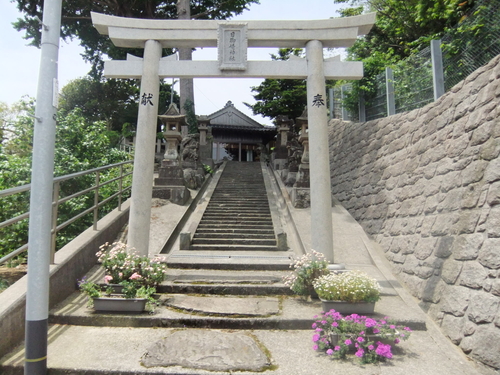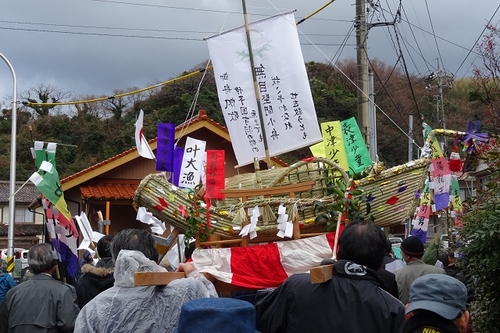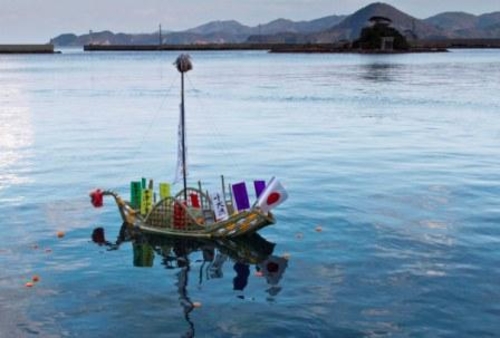Kasaura
| Bay Name | Kasa-ura |
|---|---|
| Shrine Name | Hinomisaki jinja(Former) Hinomisaki jinja(Current) |
| Deity |
Amaterasu ōmikami Emperor Ōjin Kotoshironushi |
| Location |
Matsue-shi Mihonosekichou Kasa ura |
Kasa no Hinomisaki jinja
Ima koko ni kite miru kasa no urabenaru
migiwa no shio no isagiyoki kana

The ‘Kasa no’ printed on a pilgrimage woodblock stamp dating back to the Hōei era (1709-35) is today’s ‘Kasa ura’. According to the notes of Kanezaki Zenbei, who undertook the pilgrimage during the Bunkyū era (1861-4) , it was known as Kasa –ura at that time period, too. While there is no reference to the actual name Kasa ura in the Izumo Fudoki, it’s thought that an Ashiura beach in fact, corresponds to Kasa ura.
These days, the popular name for Hinomisaki jinja is in fact ‘Ashino uramiya ’ suggesting that the old naming from the Fudoki has actually carried on through the years.
The three deities in their incongruous combination seem somewhat out of place, but perusing the Unyoushi records tells us that Kasa ura had the shrines Hinomisaki, Hachimangu and Ebisu. At that time it seems that Hinomisaki and Hachimangu were actually lined up together in the same shrine precinct, so perhaps Ebisu was enshrined along with them at a later date. Hirata town resident Omura Washiro Shigeyoshi, who went on the pilgrimage in 1866 visited both Hinomisaki and Hachimangu suggesting that the final line up of deities at Hinomisaki must have taken place during the Meiji era.
Regarding the change of location name from ‘Ashiura’ to the current Kasa ura: There was a well known stone on the beach nicknamed, ‘Kasa ishi’ (stone hat). It looked similar to the stone lanterns found at shrines. Omura Washiro is reported to have gone to see the ‘kasa ishi’, only to be told that ‘some years earlier’ during a large storm, those onboard a boat had thrown a rope around the ‘kasa ishi’ and the ‘kasa’ (hat) section had broken off and regretfully been lost to the waters.

January 7th is the Kasa ura ‘Ryūjin sai’ (Dragon god festival). The ‘Ryūjin sai began at the end of the Edo era. It is performed to ask for safety at sea and for bountiful fishing hauls. A one meter long boat named ‘‘Ryūjinmaru’ , made of straw and constructed with bamboo nails, is paraded around the town. Mikan (tangerines) are collected by the locals and are loaded onto the boat after which it is launched from the port into the waters.
While the Ryūjinmaru is being taken through the streets, it is led by someone representing the kami (god) Sarutahiko. Following behind it are two other kami, Ashinazuchi and Tenazuchi. Upon seeing any young women in the crowds, they chase after them with a large paddle, this contact with the gods symbolically represents the females being blessed with children/fertility.
The Kasa ura Ryūjinmaru is a very important part of folklore, so much so it is exhibited at the National Folklore Museum in Osaka. In the December 1983 issue of the monthly ethnology journal ‘Minpaku’ (available at the Shimane National Library), there is an article stating, “There are hints at the possibility that the ritual to dispel bad omens, ‘Kamiokuri’, may have taken place on January 7th back in the time when the year extended up to January 15th.” It continues, “ Using this theory by (famed folklorist) Yanagita Kunio, the January 7th ritual at Mihonoseki cho in Kasa ura, the Ringonsen may be a remaining trace of the expelling of bad kami (gods) that formerly took place on January 15th. The ritual originated with giving offerings of a boat laden with mikan to the sea gods who protect the waters.”
According to a thesis (also available in the Shimane National Library) by famed ethnologist Mr. Tarumi Minoru, the rituals are an ‘Exorcism performed in the sea’ citing various examples from around the country including the ‘Nagashibina’ of Tottori Prefecture (where paper dolls are floated out on the waters).
Many households in the Kasa ura area have miniature versions of Ringonsen boats on display. I’ve heard that also in Kasa bay, after the 49 days period of mourning is completed, the Shrine priest performs a purification ceremony after which people then make a visit to the shrine.
To the left of the concrete port just where the boats come in, is a nook which gives a perfect vantage point to scoop up some sea water.

| Bay Name | Kasa-ura |
|---|---|
| Shrine Name | Hinomisaki jinja(Former) Hinomisaki jinja(Current) |
| Deity |
Amaterasu ōmikami Emperor Ōjin Kotoshironushi |
| Location |
Matsue-shi Mihonosekichou Kasa ura |
Kasa no Hinomisaki jinja
Ima koko ni kite miru kasa no urabenaru
migiwa no shio no isagiyoki kana
The ‘Kasa no’ printed on a pilgrimage woodblock stamp dating back to the Hōei era (1709-35) is today’s ‘Kasa ura’. According to the notes of Kanezaki Zenbei, who undertook the pilgrimage during the Bunkyū era (1861-4) , it was known as Kasa –ura at that time period, too. While there is no reference to the actual name Kasa ura in the Izumo Fudoki, it’s thought that an Ashiura beach in fact, corresponds to Kasa ura.
These days, the popular name for Hinomisaki jinja is in fact ‘Ashino uramiya ’ suggesting that the old naming from the Fudoki has actually carried on through the years.
The three deities in their incongruous combination seem somewhat out of place, but perusing the Unyoushi records tells us that Kasa ura had the shrines Hinomisaki, Hachimangu and Ebisu. At that time it seems that Hinomisaki and Hachimangu were actually lined up together in the same shrine precinct, so perhaps Ebisu was enshrined along with them at a later date. Hirata town resident Omura Washiro Shigeyoshi, who went on the pilgrimage in 1866 visited both Hinomisaki and Hachimangu suggesting that the final line up of deities at Hinomisaki must have taken place during the Meiji era.
Regarding the change of location name from ‘Ashiura’ to the current Kasa ura: There was a well known stone on the beach nicknamed, ‘Kasa ishi’ (stone hat). It looked similar to the stone lanterns found at shrines. Omura Washiro is reported to have gone to see the ‘kasa ishi’, only to be told that ‘some years earlier’ during a large storm, those onboard a boat had thrown a rope around the ‘kasa ishi’ and the ‘kasa’ (hat) section had broken off and regretfully been lost to the waters.
January 7th is the Kasa ura ‘Ryūjin sai’ (Dragon god festival). The ‘Ryūjin sai began at the end of the Edo era. It is performed to ask for safety at sea and for bountiful fishing hauls. A one meter long boat named ‘‘Ryūjinmaru’ , made of straw and constructed with bamboo nails, is paraded around the town. Mikan (tangerines) are collected by the locals and are loaded onto the boat after which it is launched from the port into the waters.
While the Ryūjinmaru is being taken through the streets, it is led by someone representing the kami (god) Sarutahiko. Following behind it are two other kami, Ashinazuchi and Tenazuchi. Upon seeing any young women in the crowds, they chase after them with a large paddle, this contact with the gods symbolically represents the females being blessed with children/fertility.
The Kasa ura Ryūjinmaru is a very important part of folklore, so much so it is exhibited at the National Folklore Museum in Osaka. In the December 1983 issue of the monthly ethnology journal ‘Minpaku’ (available at the Shimane National Library), there is an article stating, “There are hints at the possibility that the ritual to dispel bad omens, ‘Kamiokuri’, may have taken place on January 7th back in the time when the year extended up to January 15th.” It continues, “ Using this theory by (famed folklorist) Yanagita Kunio, the January 7th ritual at Mihonoseki cho in Kasa ura, the Ringonsen may be a remaining trace of the expelling of bad kami (gods) that formerly took place on January 15th. The ritual originated with giving offerings of a boat laden with mikan to the sea gods who protect the waters.”
According to a thesis (also available in the Shimane National Library) by famed ethnologist Mr. Tarumi Minoru, the rituals are an ‘Exorcism performed in the sea’ citing various examples from around the country including the ‘Nagashibina’ of Tottori Prefecture (where paper dolls are floated out on the waters).
Many households in the Kasa ura area have miniature versions of Ringonsen boats on display. I’ve heard that also in Kasa bay, after the 49 days period of mourning is completed, the Shrine priest performs a purification ceremony after which people then make a visit to the shrine.
To the left of the concrete port just where the boats come in, is a nook which gives a perfect vantage point to scoop up some sea water.






